Commport Communications has the largest retail network, with more than 125,000 retail supply chain partners to connect and collaborate. In this EDI guide let us explore the benefits of electronic data interchange (EDI) for businesses of all sizes, discover industry-specific EDI solutions, learn different types of EDI standards, and also get to know some of the future trends in EDI technology.

In this in-depth guide you’ll learn:
So if you’re ready to go “all in” with EDI, this guide is for you.
Let’s dive right in.
In this podcast episode, we break down the summary of Commport’s EDI Guide, giving you actionable insights without needing to read the full guide. Tune in to discover how EDI can simplify your operations and help your business stay competitive in a digital-first world!
In this chapter, we will go through the history of EDI
We will also cover the definition of EDI and what does EDI stands for
Then, in later chapters, we’ll cover 'How EDI works', EDI X12 Document Types, EDI Standards
But for now, let’s cover the basics of EDI.
“Electronic Data Interchange (EDI) is defined as the electronic communication process for exchanging data amongst trading partners without human intervention. Simply put, EDI provides a technical basis for commercial “conversations” between two entities, either internal or external.”.
Back in June 1948, the Soviet Union, which controlled eastern Germany, cut off the access between western Germany and the parts of Berlin that were controlled by the U.S., England, and France by blocking the road, rail, and barge. This created a problem in delivering cargo for the US Army.
To resolve the problem a US Army Master Sargent named Edward Guilbert he is also called “The Father of EDI” designed a standard manifest system that could transmit data by telex, radio-teletype, or telephone. With this new standard manifest system in place, they were able to track tons of cargo per day until the roads to Berlin were reopened in 1949. These initial concepts later shaped the first TDCC (Transport Data Coordinating Committee) standards in the US.
Guilbert continued his work in improving the standard manifests even after he left his military duty. When Guilbert joined Du Pont Co in the 1960s he developed a standard set of electronic messages for sending cargo information between Du Pont and a carrier company, Chemical Leahman Tank Lines.
As many companies across various verticals started using EDI which allowed them to transmit documents electronically through telephone, telex messages, and radioteletype the popularity of EDI grew significantly
Among the first integrated systems using EDI were Freight Control Systems. One such real-time system was the London Airport Cargo EDP Scheme (LACES) at Heathrow Airport, London, UK, in 1971. Implementing the direct trader input (DTI) method, allowed forwarding agents to enter information directly into the customs processing system, reducing the time for clearance
In the early 1970s, a file transfer protocol (FTP) was introduced. Which enabled the transfer of files between internet sites. This FTP protocol was created as a standard in RFC989 Declarative. Which outlines certain standards like which ports are used, commands that FTP accepts, and values for the transfer parameters and modes allowed.
The first national EDI specification was published in 1975 and in the same year, the first Value added network (VAN) was also established by Telenet. Guilbert was a big contributor to developing the first national EDI specification.
In 1977, a plan was made to draft an EDI project by a group of grocery companies and their partners.
In 1978, TDCC became the EDIA (Electronic Data Interchange Association), and later EDIA was chartered by the ANSI (American National Standards Institute) to become the ANSI X12 committee which is responsible for publishing EDI standards.
As the maritime traffic increased, customs across various ports in the UK faced similar problems to those experienced at Heathrow Airport London and this led to the implementation of DTI systems in all major ports across the UK in the early 1980s
In 1981, ANSIX12 published its first standard for the food, drug, warehouse, banking, and transportation industries. Soon, many major retailers and automobile companies mandated their suppliers to use EDI to do business with them, some of the companies include Ford, General Motors, Sears, and more.
By the early 1990s many companies across various industries and verticals started adopting EDI to streamline their supply chain process, roughly 12,000+ companies mandated their suppliers to start using EDI. Then came Internet EDI (EDIINT) which was introduced by the UCC (Uniform Code Council) which standardized communications of EDI data over the internet.
As we enter the new millennium security of EDI data has become a major concern for many companies, so a new communication standard was published by UCC that enables to encrypt of transmitted data over the internet it’s called ‘AS/2’
Today, Over 95% of Fortune 500 companies are capable of using EDI. Many different types of EDI have been developed which allows much smaller to medium businesses to adopt EDI. One such cost-effective EDI solution is Internet EDI which has been widely popular among small to medium-sized businesses and requires no prior EDI knowledge, technical team, or software to use.
AS/2 has also grown its popularity as it is also cost-effective and it keeps the EDI data secure by encrypting it during the data transfer. AS/2 is now used by many major retailers like Walmart, Target Lowe’s, and many more and they require all of their suppliers to use it too.
It’s estimated that 80 percent of business-to-business traffic is conducted through EDI, and this number is growing 3 to 5 percent annually.

Over 41% of businesses have no EDI capability and 21% just use web portals.

According to Fortune Business Insights
The global electronic data interchange software market size was $1,547.2 Mn in 2019 & is projected to reach $3,451.3 Mn by 2027, at a CAGR of 10.7% in the forecast period

According to the grand view research industry analysis report,
The global healthcare Electronic Data Interchange (EDI) market size was valued at USD 2.7 billion in 2016 and is expected to grow at a CAGR of 9.4% during the forecast period
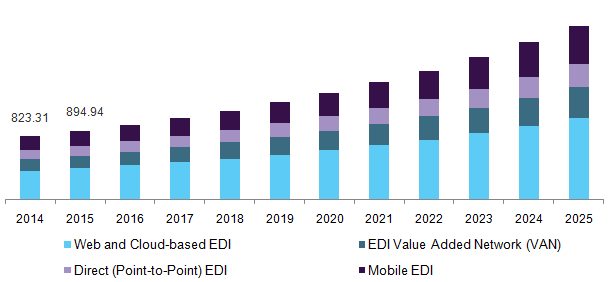
EDI, or Electronic Data Interchange has changed the way businesses manage and process their information on a grand scale. EDI solutions save immeasurable amounts of time and lost revenue from clerical errors.
Simply put, EDI provides a technical basis for commercial “conversations” between two entities, either internal or external.
EDI encompasses the entire electronic communication process including,
Using EDI, companies send information digitally from one business system to another, using a standardized format. EDI automates the order processes, transactions, and communications that were done with paper or fax in the past.
Businesses can exchange digital information and transactions such as purchase orders, invoices, advanced ship notices, and other documents via EDI with greater accuracy and speed.
As supply chains become more complex, EDI offers the technology you need to connect your systems, trading partners, demand channels, and customers.
EDI creates a bridge between your internal systems, your partners’ systems, and a variety of sales platforms, such as online marketplaces or eCommerce storefronts. By automating the transfer of data between these systems, EDI can quickly process large order volumes, eliminate errors and delays, and streamline communications across your supply and demand channels
Think of EDI as a common electronic business language that allows trading partners to quickly and easily communicate with each other.
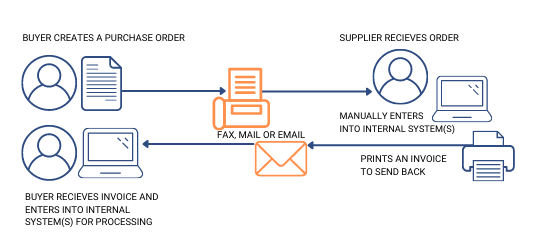
Before EDI, businesses relied on moving paper-based documents, which would take far too long and did not provide the flexibility that an electronic exchange would.
In manual process, businesses exchange documents via postal mail, fax and email.
Step 1 – The buyer either receives a notification in his system to place an order or, after querying the inventory, determines he needs to place an order.
Step 2 – The buyer enters data onto the screen of a purchasing system to create the PO, print and mail it, or email it to the vendor.
Step 3 – The vendor receives the PO, either day later or via email (along with a long list of other communications) and manually enters it into the sales order system.
Step 4 – The vendor prints an invoice and encloses it with the shipment and/or sends it separately by mail or email.
Step 5 – The buyer manually enters the invoice into the accounts payable system.
With the manual process, it could take weeks or sometimes months of back-and-forth shipping time to the process. Also, it is susceptible to manual data entry errors and increasing order time.
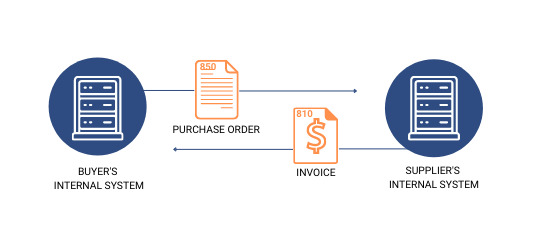
EDI replaces the manual exchange of B2B documents. With EDI documents flow directly from the sender’s computer application (e.g.: A logistic system) to the receiver’s computer application (e.g.: an order management system)
Step 1 – The buyer’s procurement system, which uses EDI, auto-generates and sends an EDI-formatted PO when inventory reaches a pre-specified level.
Step 2 – In minutes the vendor’s sales order system, using EDI software, receives the EDI PO.
Step 3 – The supplier’s system automatically notifies their shipping department to send goods.
Step 4 – Once the goods are packed and ready to ship, the shipping system generates an Advanced Ship Notice (ASN) to send to the buyer’s receiving department
Step 5 – The vendor’s ERP system then generates an EDI invoice to transmit to the buyer’s accounts payable system
With the automated EDI system in place, the entire process can be completed in less than 1 hour.
Using EDI doesn’t just save your business time and money. It also makes it easier and more cost-effective for your partners to do business with you. This gives you an edge over your competitors. When you’re easier to do business with, you can do business in every direction
EDI dramatically simplifies the exchange between a buyer and supplier. A buyer’s internal system uses EDI to send a purchase order, which is accepted by the supplier’s internal network. Everything is exchanged in real-time without the need for faxing, mailing, or manual entry.
Electronic data interchange is now widely used both in the United States and globally, based on several standards that have been enacted that provide basic guidelines for its use. The two standards bodies that are most frequently associated with Electronic Data Interchange are the ANSI X12 standard, used primarily in the US, and the UN EDIFACT standard is used outside of the United States
Today, industries use EDI integration to share a range of document types — from purchase orders to invoices to requests for quotations to loan applications and more. In most instances, these organizations are trading partners that exchange goods and services frequently as part of their supply chains and business-to-business (B2B) networks.
There are 8 Types of EDI solutions which include:
There are many methods organizations will use to enable EDI across their trading community.
Electronic data interchange (EDI) is one of the most common forms of structured electronic exchange of business documents between organizations.
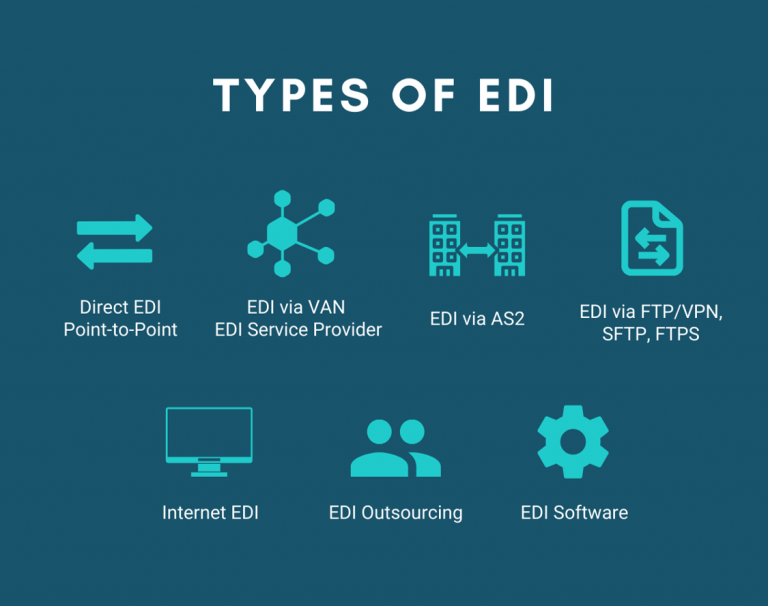
An integrated EDI solution translates your inbound documents like purchase orders from your trading partners’ EDI files into a format that can be imported directly into your ERP, accounting, or another business system.
When you’re ready to send out invoices, PO acknowledgments, or other outbound documents, it takes the format exported from your system and translates it into the EDI formats required by your trading partners.
The translation is fast and reliable so you can focus on your business
Integrate business documents with your internal operations.
Achieve seamless translation, converting business system documents into documents that are global standards compliant.
Mappings and translation are managed by Commport, so there is no software to install or maintain.
Exceed your trading partner’s needs with documents that are formatted to meet their specific business requirements.
Connect directly with your trading partners using protocols such as AS2 or sFTP.
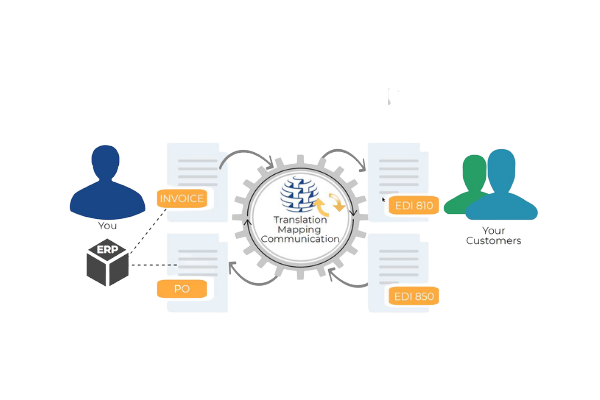
Communication of EDI messages over the Internet.
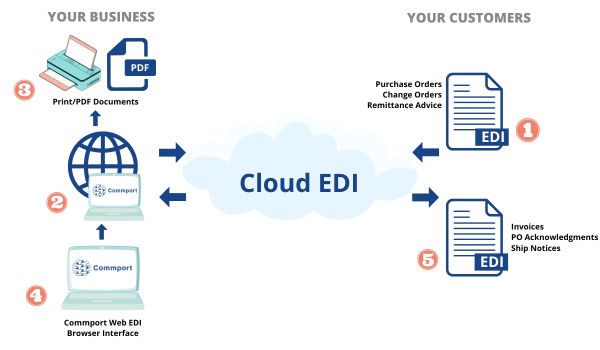
Your customer sends an EDI Purchase Order (PO) the way they do with all of their EDI suppliers.
Cloud EDI is an economical solution that is easy to use. Even smaller or mid-sized vendors need to be compliant with their large retail customers. As a low-cost option, Internet EDI enables you to get up and running with very little
Investment required. All you need is an Internet connection and a web browser and you can begin exchanging EDI with your trading partners today.
The straightforward Internet EDI document interface is user-friendly and doesn’t require a lot of experience with EDI systems. It tailors the screen to include only the information requested by your trading partners. All forms include business rule validations and controls, ensuring effortless compliance with your trading partner’s EDI programs.
EDI outsourcing is the process of having a third-party company like Commport Communications manage a part or the entire process of using EDI to exchange data with trading partners. While businesses of many sizes use EDI outsourcing, the primary benefit is usually associated with smaller businesses.
EDI outsourcing is also suitable if you have implemented a fully integrated EDI-compliant system but still have partners who want to send you faxes.
By outsourcing your EDI, you set yourself free to focus on your business and what you do best. EDI outsourcing means that you will not need to make any investment in EDI software, nor will you have to directly manage the EDI aspect of your relationship with your customers, including large retail clients.
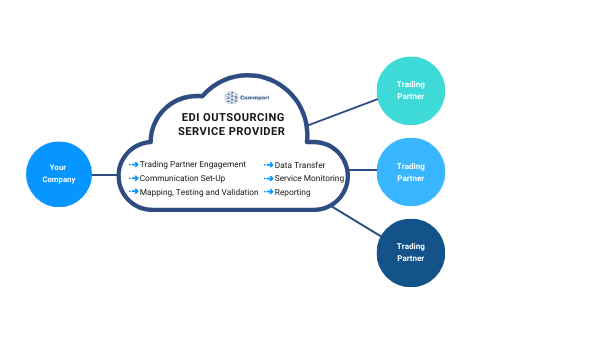
Direct EDI, sometimes referred to as point-to-point EDI, establishes a single connection between two business partners. In this approach, a business would connect with each of its business partners individually. Typically large corporations that have business partners with whom they exchange a high volume of EDI documents will choose this method.
While Direct EDI provides more control for each business, it can become very complex quickly. Different EDI trading partners often use separate communication protocols which means you need to support each available option.
With the direct connection model, you will need to purchase a software package that enables you to use all the agreed-upon protocols.
AS2 stands for Applicability Statement 2. Easily described as a business-to-business connection in a point-to-point manner via the web. AS2 is one of the most popular methods for transporting EDI data securely and reliably used by millions of businesses, including most major retailers, such as Amazon and Walmart.
sFTP stands for Secure File Transfer Protocol, also called SSH File Transfer Protocol, and is a network protocol for accessing, transferring, and managing files on remote systems. sFTP provides organizations with a higher level of file transfer protection which allows businesses to securely transfer billing data, funds, and data recovery files.
FTPS stands for File Transfer Protocol Secure which is an extension to the commonly used File Transfer Protocol. In FTPS, FTP data travels through the network using either Secure Sockets Layer (SSL) or Transport Layer Security (TLS) protocols.
The majority of EDI exchanged today occurs through EDI Value-Added Network (VAN). As long as two organizations are using the same VAN, communication is possible regardless of which EDI protocol is used to transfer information. Unlike Direct EDI this means organizations can manage one connection with the EDI VAN instead of separate lines of communication with each potential partner. Many businesses prefer this model to save them from the ongoing complexities of supporting the varying communication protocols required by different business partners.
100% EDI Compliance Guaranteed!
In this chapter, we will go through information related to EDI Compliance
We will also cover what is EDI Compliance and why businesses need to be EDI Compliant to do business with all major trading partners
Then, as we go into details, we’ll also cover topics like
'Why do you need an EDI solution?',
Who can use EDI?'
The importance of EDI for small & medium businesses.
What do you need to get started with EDI?
EDI compliance refers to a business’s capacity to accurately send and receive EDI transactions according to the order data requirements of its EDI trading partners. Each document must adhere to a specific EDI format to ensure the successful exchange of EDI documents.
Many companies insist that their trading partners communicate using EDI providers, including retail giants like Walmart, Target, Costco, and Amazon.
Each retailer indicates which specific documents your business must follow to complete business and become EDI compliant. This means that your trading partner’s EDI requirements can change at any time. So your EDI partner needs to make the necessary adjustments, such as EDI mapping, on your behalf so you can continue business as usual and stay EDI compliant.
With virtually all major trading partners demanding that businesses who wish to trade with them be EDI compliant, the importance of building and maintaining EDI compliance cannot be understated, especially given how it can benefit your bottom line.
At its most basic level, EDI compliance means your business can use EDI to receive your purchase orders and send out invoices.
Solid, trust-based relationships built on being EDI capable foster confidence and business growth. EDI implementation issues are not only frustrating, but they can also be costly. And that cost of being non-compliant comes in the form of EDI chargebacks.
EDI chargebacks are financial penalties for non-compliance with your trading partner’s requirements. Trading partners issue EDI chargebacks because of vendor non-compliance with agreed-upon elements of the Service Level Agreement (SLA). Because vendor non-compliance disrupts operations and creates additional expenses for the trading partner, the customer offsets those additional costs by issuing EDI chargebacks to the vendor.
There are a few key steps in the process of becoming EDI compliant. You first need to understand the requirements of your specific trading partner. Most trading partners will have resources on their websites that detail the full set of requirements & expectations concerning EDI. You then have a choice. You can either outsource your EDI requirements to a third-party provider such as Commport Communications, or you can build an in-house EDI solution.
For the vast majority of businesses, building an in-house EDI solution from scratch is both a daunting & expensive process. This process involves developing the software needed to securely exchange EDI documents. After your EDI solution is all setup, you’re ready for the final step: testing. You must test your EDI solution to ensure that the documents can successfully be exchanged in the proper format with your trading partner(s). After testing is done with the trading partner, you’re ready for business!
To answer the question of why you need an EDI solution, first, you may want to ask yourself how much time and money you are spending on your current manual paper process. If the calculation of time and expense justifies the investment for migrating to an EDI solution, then it’s something you need to strongly consider.
Consider the hundreds of pages you have to create and pile through every day to run your business. Consider all of the time it takes to interface all of these documents with other businesses and systems to keep moving forward. Are you as efficient as you need to be to succeed?
EDI solutions (Electronic Data Interchange) are designed to help you manage this massive amount of paperwork. The considerations for savings in time, potential errors from mistyped or incorrectly logged information, and the impact on the environment—all these are important considerations when you’re looking into an Edi solution for your business.
If your business model is based on having a series of processes that are labor intensive—yet completely necessary—in regards to a huge amount of work required to keep things running, then you will want to consider an EDI solution.
Manage Hundreds of Pages
One of the major benefits of an EDI solution is the automation of the otherwise manual process of managing hundreds of pages of paperwork and documentation that would otherwise be done by a human agent. There is a great deal of work that goes into creating the documentation and pushing it through to the next stage, not to mention managing that documentation at the various links throughout the process. At every stage, there is the potential for errors, and these errors all limit your productivity and present potential costs.
If your business relies on paper documentation and needs to process hundreds of similar paper orders daily, an EDI system can save you considerable time and money. The other consideration is the savings in time by being able to take multiple steps out of your process.
There are various levels of EDI integration system VAN to be customized based on how your company operates. It can be as simple or as complex as you need it to be.
Commport’s Integrated EDI solution can be scaled up or down depending on your needs. We have developed solutions for companies in various industries, including healthcare.
EDI (Electronic Data Interchange) refers to the process of exchanging form information electronically. In many cases, it has saved thousands of hours (and countless dollars) for businesses with scores of documents to complete and file.
EDI has been used in the past primarily by automotive and retail businesses, however, in the past few years, the format has been more widely adopted. Manufacturing, healthcare, pharmaceutical, utility, and construction companies are good examples of EDI clients.
Here is the list of EDI use cases in various industries,
Any type of business that deals with large amounts of identical paperwork/form data can directly benefit from adopting an EDI solution
Security of information is critical. The adoption of EDI infrastructure is also largely due to the convenience and security of EDI. EDI used over a VAN (Value Added Network) is an even more secure way to ensure the data is reaching its destination and is being managed properly.
A retailer attempting to implement a “just-in-time” inventory philosophy (that is, cutting down on overstocked inventory and replacing inventory in demand) would do well to implement an EDI solution.
There are two common forms of translation for Electronic Data Interchange a machine-to-readable format, also known as “rip and read” that creates a printed report, and the automatic translation of Electronic Data Interchange into an ERP or accounting system, also known as Integrated Electronic Data Interchange.
Electronic Data Interchange can be used in a variety of information transactions, including but not limited to:
Major retailers – Walmart, 99 Cents Only Stores, Lowes, Office Depot, and Costco, to name a few – use EDI to manage their transportation and routing instructions.
it’s possible to use EDI to integrate purchase orders into the sales order system simply and efficiently. Files can then be archived for accurate accounting and reporting, as well as for future reference during the drafting of additional documents.
Invoice processing is an essential component of effective business practice – EDI ensures accurate and fast invoicing, eliminating inaccuracies and facilitating fast payment.
EDI can extract data from an Advanced Shipping Notice infrastructure and produce a clear graphic depiction of sequential processing steps. Furthermore, EDI is commonly used for remote and third-party warehousing fulfillment processes.
EDI solutions can expedite the delivery of current products and pricing information to any partners, providing individualized information pertinent to the specific needs of the particular partner, in their required format.
EDI was invented for the benefit of companies that needed to transfer thousands of documents on any given day between trading partners and suppliers.
Over time large retailers often mandate the use of EDI to small and medium-sized suppliers forcing them to comply with EDI standards to continue to do business with them. Small businesses tend to adopt the most affordable web-based internet EDI solutions over other expensive integrations like integrated EDI solutions.
While small business owners may not prioritize information transfer solutions, exploiting the efficiencies of EDI may help small to medium-sized organizations compete in challenging markets.
Benefits for small and medium businesses to switch to EDI,
EDI can replace some of the manual office tasks such as processing purchase orders, updating inventories, and sending invoices, thus saving thousands of dollars in salaries and wages.
As the business grows it can be difficult for small businesses to handle the processing of documents manually which can significantly impact customer relationships and delay the overall process. With an effective EDI solution, small businesses can drastically improve productivity by implementing a fully automated EDI system.
The best part of using an effective EDI solution is that the system adapts to changes concerning the business process as your company begins to grow.
Small businesses may find Electronic Data Interchange integration a challenge, but those that want to build relationships and partner with large organizations should consider incorporating EDI into their current supply chain strategy.
So what do you need to get started? First of all, lay out your process for handling documents from one side of the chain to the next. What is the process? Does it require a great amount of manual intervention? Think of how many places in the process where a human agent is necessary to move the process to the next stage.
Think about how much variation exists between documents. Consider that with an EDI solution, there should be seamless migration from one system to another. The less human intervention required, the better the system will perform.
Next, identify your internal network. What are you currently using to move your processes forward? How would you benefit from having an EDI solution in place? What would it replace? Have you considered the time and energy considerations for implementing an EDI solution?
Once your documents have been brought to a certain level, how are they to be passed to the next stage?
Once you have identified these steps, you will be that much more prepared to integrate an EDI solution to manage a lot of the legwork currently going into your document tracking and submitting process.
What type of infrastructure do you need to have in place? The great thing about modern EDI solutions (Commport offers several solutions, including EDI software solutions like CyberLiNK) you do not have to have more than an Internet connection and the proper software installed to make use of the many advantages of EDI.
The nature of Commport’s solutions is to apply optimum security right out of the gate, so you don’t even have to think about it.
The main thing to consider is that you identify the goal and purpose for integrating the EDI solution. Once you have that, integrating the physical system is made easy with Commport’s Integrated EDI solutions.
So really, all you need to ensure you are prepared for EDI is a requirement to save time and money in your document-creating, compiling, and submitting process.
Unlock the full potential of your supply chain with our comprehensive EDI Buyer's Guide — your first step towards seamless, efficient, and error-free transactions
In this chapter, we will be explaining 'How EDI Works'
We will also cover why EDI standards are important and are the basis of EDI conversations
Then, as we go in detail, '60 benefits of EDI', EDI costs, EDI implementation
All EDI transactions get defined by EDI message standards. It is vital to have proper governance processes for data quality. When information is missing or in the wrong place, the EDI document might not be processed correctly.
Standards are the basis of EDI conversations.¹ Several organizations define the EDI message standards, including ODETTE, TRADACOMS, GS1, Peppol and the Accredited Standard Committee X12 (ASC X12).
In general, there are two basic types of EDI transmission:
EDI internet transmission protocols include Secure File Transfer Protocol (SFTP), Applicability Statement 2 or AS2, an HTTPS-based protocol, Simple Object Access Protocol (SOAP), and others. EDI data elements include items such as sender ID and receiver ID. Data segments combine two or more related elements to give them greater meaning. For example, FNAME and LNAME can combine to form CUSTOMERNAME. Envelopes structure different types of data and carry the sender and receiver address information. EDI document flow or message flow describes the movement of EDI messages to various inbound and outbound addresses and departments to execute a business process or transaction.²
Metalanguages such as Extensible Markup Language (XML) or JavaScript Object Notation (JSON) complement rather than replace EDI. Companies must be ready to handle an ever-increasing number of document formats and transmission options. One global manufacturer routinely exchanges about 55 different document types with nearly 2,000 partners.
There are three steps in the process of sending the EDI documents,
We will consider a real-time scenario to Illustrate the EDI process for purchase orders and invoices.
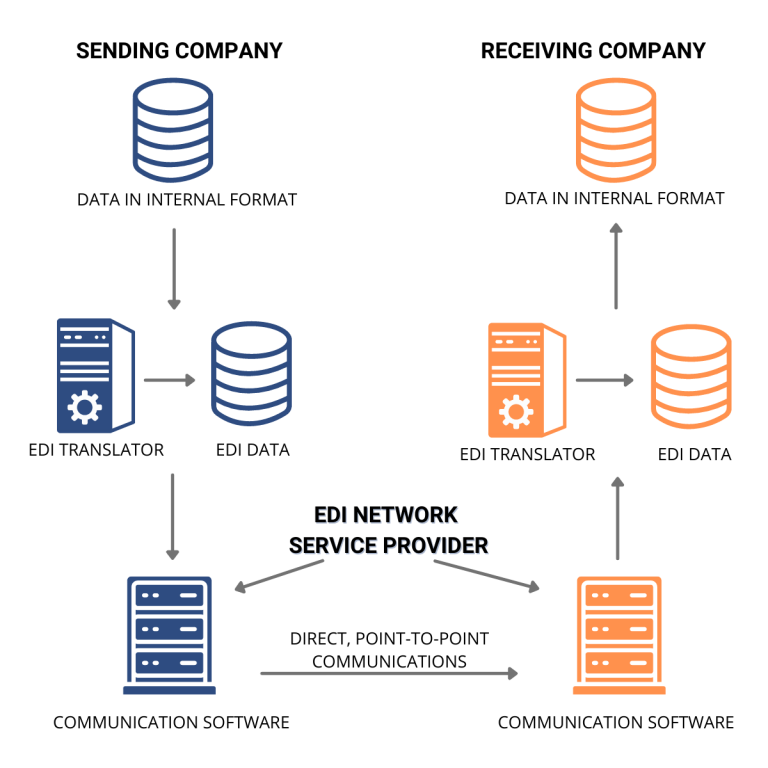
Following the example of a PO and invoice, this is where a buyer prepares an order in a purchasing system.
So how would you properly prepare documents? There are several approaches, including:
Ideally, you would want your system to eliminate as much human data entry as possible to save time and improve accuracy.
The next step is to feed your document through EDI translation software to convert your internal data format into the EDI standard format using the appropriate segments and data elements. Alternatively, you can send your data to an EDI service provider, who handles translation to and from the EDI format on your behalf.
In our example, the PO is translated into an EDI 850 purchase order document.
Once the PO is translated to the EDI 850 purchase order format, it’s ready for transmission to the supplier. There are several ways to connect to a partner via EDI. The most common include:
In the case of an EDI network provider, or value-added network (VAN), the buyer uses their preferred communications protocol, ensuring reliable, secure EDI transmission. Then, the network provider connects to the supplier using the supplier’s preferred communications protocol, ensuring the supplier receives the order. VANs can reduce setup and maintenance in some cases but tend to be more expensive than point-to-point integration for many use cases, as they charge a fee for each transaction or even line item.
EDI allows companies to easily adapt document transfers based on the specific requirements of each retailer or supplier, like unique pricing structures or ship-to-ship address requirements. Depending on the configurations used, the entire process can be electronic. By eliminating the reliance on paper, businesses can reduce to cost of transactions by more than 50%.
Here are some of the important integrated EDI benefits,
Achieve seamless translation
Reduce costs, improve cash flow
Increase accuracy and boost productivity
Easy inventory control
In this chapter, we will be explaining
'What are EDI standards'?
'10 common EDI communication standards used by various industries
'Importance of each communication standards'
EDI communication standards are the requirements for the format and composition of EDI documents. EDI standards delineate the correct order and location of units of data in a given EDI document.
EDI standards began to emerge in the mid-1980s, and were purposely designed to be entirely separate (not dependent upon) changes in communication and software technologies
Because EDI documents must be processed by computers rather than humans, a standard format must be used so that the computer will be able to read and understand the documents.
American National Standard Institute (ANSI) founded the Accredited Standards Committee (ASC) in 1979 to develop uniform standards for the inter-industry electronic exchange of business transactions, namely electronic data interchange (EDI). This standard is also sometimes called ANSI X12 Standard or just simply X12.
ANSI X12 was originally developed to support companies across different industry sectors in North America however, today there are more than 300,000 companies worldwide using X12 EDI standards in daily business transactions.
Each EDI X12 transaction type is differentiated by a unique 3-digit number and there are more than 300 different types of X12 EDI standards for various industries from finance, government, healthcare, insurance, banking, transportation, and many more. ASC also contributes to UN/EDIFACT messages that are used widely outside of the United States and develops standards for CICA (Context Inspired Component Architecture) and XML schemas.
Download the full list of EDI X12 Transaction Codes
Tradacoms (Trading DAA Communications) is an early EDI standard that was originally introduced in 1982 and was primarily used in the UK retail sector. It was maintained and extended by the UK Article Numbering Association, now called GS1 UK. Slowly this standard become less obsolescent as its development of it effectively ceased in 1995. Despite this, it has proved durable and most of the retail EDI traffic in the UK still uses it today.
TRADACOMS uses multiple messages instead of relying on a format of single messaging. TRADACOMS communication is comprised of 26 messages structured in a hierarchy. Each TRADACOMS message, much like EDIFACT, is given a six-letter application reference. For example, an invoice message is INVFIL, a payment order is PAYORD, a utility bill is UTLHDR, and so on.
United Nations/Electronic Data Interchange for Administration, Commerce, and Transport is the international standard that was developed by the United Nations. The work of maintenance and further development of this standard is done through the United Nations Centre for Trade Facilitation and Electronic Business (UN/CEFACT) under the UN Economic Commission for Europe. The EDIFACT standard provides a set of syntax rules to structure, an interactive exchange protocol, and provides a set of standard messages which allow multi-country and multi-industry exchange of electronic business documents. EDIFACT is widely used across Europe, mainly because many companies adopted it very early on. EDIFACT has seen some adoption in the ASPAC region, however, there are currently more XML-based standards being used in this particular region today.
UN/EDIFACT, which is short for United Nations Rules for Electronic Data Interchange for Administration, Commerce, and Transport, is a set of internationally standardized communication guidelines for exchanged data tags and message types between computer systems in different networks. UN/EDIFACT standards structure data into segments, segments into messages, and messages into an interactive exchange protocol.
The syntax rules for EDIFACT describe the message (nesting, character sets, structures, etc.) The data tags detail the different types of data being exchanged and how each is represented. The message types are also known as UNSMs (United Nations Standard Messages).
ODETTE stands for Organization of Data Exchange by Tele Transmission in Europe and creates data exchange and communications standards for the European automotive industry. It is similar to North America’s AIAG (Automotive Industry Action Group). ODETTE develops protocols such as OFTP and the more advanced OFTP2, which provide enhanced security through encryption methods and digital certificates for EDI data exchange.
Deploying B2B and MFT (managed file transfer) solutions that are ODETTE-certified for OFTP and OFTP2 allows a company to securely and efficiently communicate with various software to successfully exchange data.
The Organization for Data Exchange by Tele Transmission in Europe is a group that represents the interests of the automotive industry in Europe. They are the equivalent of the Automotive Industry Action Group (AIAG) in North America. The organization develops tools and recommendations that improve the flow of goods, services product data, and business information across the whole automotive value chain. ODETTE has been responsible for developing communications standards such as OFTP and OFTP2.0, constant improvement processes such as Materials Management Operations Guideline / Logistics Evaluation (MMOG/LE), and automotive-specific document standards as defined via the link below.
This standard was originally conceived in 1987 by the EAN General Assembly and was to be developed on the then-emerging international UN/EDIFACT standard. The EANCOM messages, maintained by GS1, are more detailed compared to the TRADACOMS message set. EANCOM was originally developed for the retail sector and has subsequently grown to become the most widely used UN/EDIFACT subset and is now found in a variety of other industry sectors such as healthcare, construction, and publishing.
EANCOM provides a logical sequence of messages used in business. Trading companies agree together on messages adapted to their needs. Standard messages available in EANCOM can be divided into the following categories, Master Data, Commercial Transactions, Report & Planning, and Transporter.
The Voluntary Inter-industry Commerce Standard is used by the general merchandise retail industry across North America. It is a subset of the ANSI ASC X12 national standard. VICS EDI is being utilized by thousands of companies, department and specialty retail stores, mass merchandisers, and their respective suppliers. In 1988 GS1 US became the management and administrative body for VICS EDI. GS1 US also manages the ASC X12-derived Uniform Communication Standard (UCS) for the grocery industry and the Industrial/Commercial Standard (I/C) for the industrial sector.
This organization develops standards and best practices to serve the needs of companies within the German automotive industry. The VDA has developed over thirty messages to meet the need of companies such as VW, Audi, Bosch, Continental and Daimler AG. Further information about these messages can be found via the link below.
VDA develops standards and best practices to serve the needs of companies within the German automotive industry. The VDA has developed over thirty messages to meet the need of companies such as VW, Audi, Bosch, Continental and Daimler AG.
The Health Insurance Portability and Accountability Act was enacted by the U.S. Congress in 1996. A key component of HIPAA is the establishment of national standards for electronic healthcare transactions and national identifiers for providers, health insurance plans, and employers. The standards are meant to improve the efficiency and effectiveness of the North American healthcare system by encouraging the widespread use of EDI in the U.S. health care system. The HIPAA EDI transaction sets are based on X12 and the key message types are described below.
This consists of a consortium of major computer, consumer electronics, semiconductor manufacturers, telecommunications, and logistics companies working together to create and implement industry-wide, open e-business process standards. These standards form a common e-business language, aligning processes between supply chain partners on a global basis. The RosettaNet document standard is based on XML and defines message guidelines, business processes interface, and implementation frameworks for interactions between companies. Using RosettaNet Partner Interface Processes (PIPs), business partners of all sizes can connect electronically to process transactions and move information within their extended supply chains. Further information about RosettaNet PIP documents can be found at the link below.
The Society of Worldwide Interbank Financial Telecommunication was formed in 1973 and is headquartered in Brussels. SWIFT operates a worldwide financial messaging network that exchanges messages between banks and financial institutions. SWIFT also markets software and services to financial institutions, much of it for use on the SWIFTNet Network. SWIFTNet is the infrastructure used to exchange these documents and FIN, InterAct, and FileAct are used to encode the SWIFT documents for transmission. The majority of interbank messages use the SWIFT network. As of November 2008, SWIFT linked 8740 financial institutions across 209 countries. The SWIFT document standard is split into four areas, Payments, Trade Services, Securities, and Trading.
EDI has been the backbone of B2B communication for decades, streamlining the exchange of business documents between trading partners. According to recent studies, over 85% of all electronic business transactions occur using EDI, and the global EDI market is expected to reach a whopping $25 billion by 2025.
One of the most notable trends shaping the future of EDI is the migration to cloud-based solutions. Traditional EDI systems often come with hefty infrastructure costs and maintenance challenges. However, with cloud-based EDI, companies can enjoy greater flexibility, scalability, and cost-effectiveness. Research indicates that the adoption of cloud-based EDI is set to grow at a CAGR of over 10% in the coming years.
As concerns about data security and transparency take center stage, the integration of blockchain technology into EDI processes becomes increasingly likely. Blockchain’s decentralized and tamper-resistant nature can enhance the security of EDI transactions, reducing the risk of data breaches and ensuring the integrity of exchanged documents.
The future of EDI is not just about transmitting data but leveraging it intelligently. Machine learning algorithms and predictive analytics are set to play a pivotal role in optimizing supply chain management and predicting business trends. By analyzing historical EDI data, companies can make informed decisions, minimize errors, and enhance overall operational efficiency.
In the future, EDI systems will become even more interoperable, fostering seamless communication between diverse platforms and protocols. This enhanced interoperability is crucial as businesses increasingly operate in a global ecosystem, collaborating with partners who may use different EDI standards. The rise of standardized protocols and advanced mapping technologies will facilitate smoother data exchanges.
Commport Integrated EDI solution translates your inbound documents, like purchase orders, from your trading partners’ EDI files into a format that can be imported directly into your ERP, accounting, or other business system.
Commport’s Integrated EDI software as a service solution is a proven and cost-effective platform without the initial outlay associated with traditional EDI Software.
Integrate your EDI information with your specific business systems, including Sage and Microsoft software options. Commport’s Integrated EDI software as a service (SaaS) solution is a proven and cost effective platform without the initial outlay associated with traditional EDI software.
Users of Commport’s integrated software enjoy the benefits of streamlined EDI processes that are electronically, verses manually driven. This results in reduced error rates and confidence in reliable data maintenance that is integrated throughout the EDI document sharing process.
If you manage a high volume of EDI documents, Commport’s Integrated EDI solution can help you to reduce the hours of manpower required to re-key information into your internal accounting and business systems.
At best, a manual process of re-keying data is time consuming, costly, and can be a drain on your resources. At worst, a manual process is at risk for re-keying errors that can occur when data is manually entered into multiple systems.
An Integrated EDI solution translates your inbound documents, like purchase orders, from your trading partners’ EDI files into a format that can be imported directly into your ERP, accounting or other business system.
When you’re ready to send out invoices, PO acknowledgments or other outbound documents, it takes the format exported from your system and translates it into the EDI formats required by your trading partners.
Translation is fast and reliable – so you can focus on your business.
The solution grows easily as your business grows and adding new customers is easy.
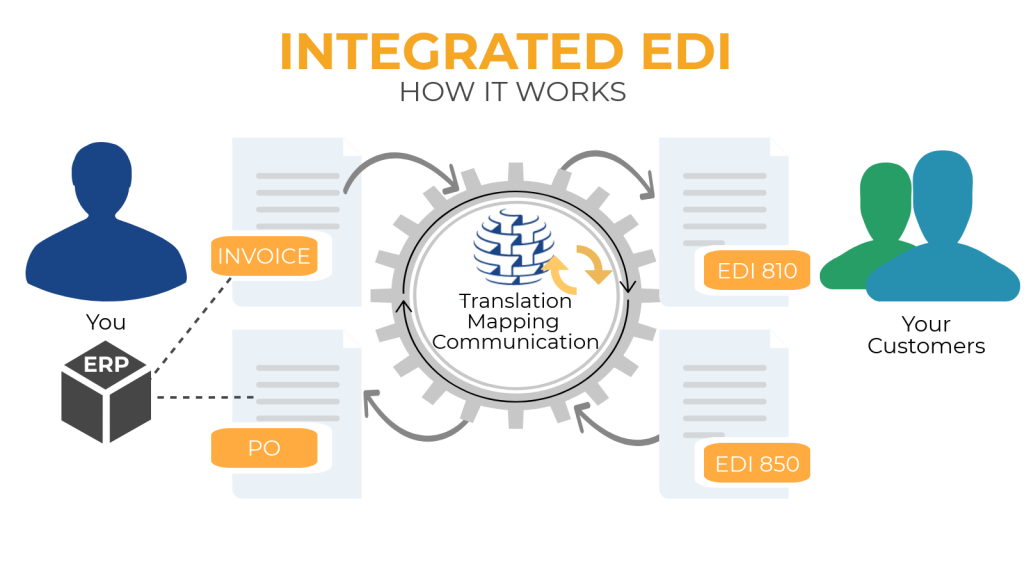
This quick infographic breaks down how an integrated EDI solution works, the difference between cloud EDI and finally the benefits of having an Integrated EDI solution for your business.
Key Features of Commport’s Integrated EDI solution:
Commport is a single-source solution with a commitment to end-to-end service: we own and operate 100% of the infrastructure and provide the service and support to back it up
Unlock efficiency and enhance your supply chain with our Integrated EDI Solution—say goodbye to manual processes and multiple systems. Learn all you need to know about Integrated EDI and make an informed choice.
In this current digital world, using EDI can give businesses a competitive advantage. It can manage crucial aspects of your supply chain lifecycle efficiently with little to no effort. It helps you take care of your internal processes and allows you to build better trading partner relationships.
Without EDI, all you have is manual processes that require human intervention. The biggest IT challenge that many organizations face is the integration of different applications and systems. Data flow is interrupted in the absence of an effective EDI solution, and data fragmentation hurts businesses. Without EDI integration, many B2B businesses fail to provide exceptional support to their customers..
No doubt, investing in an EDI solution offers long-term benefits. If you’d like to become compliant and take a competitive advantage over your competitors, then it’s time to set your EDI integration goals.
If you are looking for an end-to-end integrated EDI solution look no further and contact the Commport team. We provide the most affordable and reliable EDI solutions in the market. Trusted by 6000+ customers and rated as one of the top EDI providers. We guarantee 100% EDI compliance to all our cusotmers.
To start with EDI, a business needs to assess its requirements, choose a compatible EDI solution, map its data for the EDI format, and set up secure transmission channels. Partnering with a reliable EDI provider can simplify this process and offer ongoing support for successful integration.
Common EDI standards include ANSI X12, EDIFACT, and XML-based EDI. These standards ensure that data exchanged between systems is uniform and consistent, enabling smooth communication across various platforms and industries.
The main types of EDI solutions include integrated EDI, which connects directly with internal systems; cloud EDI, which is managed online; and web-based EDI, suitable for smaller businesses. The choice depends on the volume of transactions and integration requirements.
EDI is widely used across industries such as retail, manufacturing, healthcare, logistics, and automotive, where there is a need for fast, accurate, and efficient data exchanges between suppliers, partners, and customers.
EDI offers several benefits, including reduced processing time, lower costs by minimizing paper use, increased data accuracy, improved business relationships, and better supply chain management.